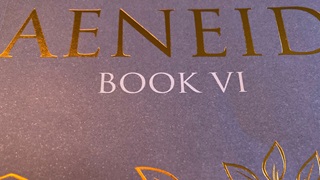
Shakespeare
Shall I compare thee to a summer's day? | Alexandra Howe reads sonnet 18 | Issue 20 | 2022


The essay by Alexandra Howe
The year is 1833. We are in Flintshire, not far from the north coast of Wales, about a quarter of a mile from the town of Mold. The River Alyn slips past to the left, shrouded by smooth grey willow and fissured alder trunks. To the right, rising out of the tufted hair-grass and creeping bell heather, is a gravel mound known as Bryn-yr-Ellyllon, the Goblins’ Hill. Travellers have avoided this place after dark, ever since the ghostly boy was first sighted.
An old woman making her way home late one night, had reported an apparition 'clothed in a coat of gold which shone like the sun', that flickered across her path and climbed the mound before dissolving into the gauzy air. How mysterious, that the very man to whom the old woman recounted her tale the following morning, should now, years later, be quarrying stone with his workmen in the spot where the wraith disappeared, and, digging deep into the bank, should uncover a stone-lined grave containing the crushed remains of a skeleton enfolded by an extraordinary cape of pure beaten gold.
For over three and a half thousand years after his stately burial, the wearer of the cape has lain in his golden wrapping. Within hours of discovery, the cape is ripped from him, torn apart and distributed among the jubilant workmen; his worthless skeleton is discarded and forgotten. Nothing beside remains. There is little legal protection for ancient burial sites, and it occurs to no one that there is any value in the find beyond the gleaming shreds of gold.
It will be another 130 years before the British Museum is able to re-assemble the paper-thin fragments, exquisitely worked in a design of looping beads and ridges that have been painstakingly punched out from the underside. Then it will become clear that the cape is made from a single sheet of hammered gold, expertly decorated and moulded into a short mantle which would have fitted over the shoulders and upper arms, coming down to the middle of the chest of the wearer. It is an object of such exceptional fragility and luxury that it can only have been used on ceremonial occasions, by someone who surely commanded enormous wealth and power in early Bronze Age Britain.
This cape was produced by a sophisticated society, perhaps linked to the contemporary Great Orme copper mines a few miles away. But it is also relatively small, about a foot and a half wide and just under a foot deep. Its size suggests that it was probably worn by a slender person, a youth; in 1700 BC, when the cape was made, few people would have lived beyond their mid-twenties, and a teenager may already have been a powerful ruler.
Unfortunately, without the crucial evidence of the skeleton, we will probably never know any more about the wearer of the Mold Gold cape. Powerful as he may have been in life, in death he is nothing at all to the workmen, who squabble over the largest scraps of the spoil.
Looking at the cape now, mounted in its glass case in the British Museum, it seems that this object and its story draw together several aspects of the significance that gold appears to hold for us: beauty, decoration, mystical power, wealth, fascination, greed. Robert Weinberg is a gold analyst; in 1992, he wrote: “Gold fills many different roles simultaneously. It can be an adornment and an industrial metal, a means of displaying wealth and an anonymous form of saving, an insurance policy and a gambling chip; it is an international reserve asset yet officially it is not money. In short, it represents different things to different people and they will be driven by different motives at different times.”
Gold is hardly practical. It is malleable and easy to work. The maker of the Mold Gold cape must have seen this as an advantage, but it can be a drawback in industry, where it must generally be alloyed with other metals to make it harder. It is a good conductor of heat and electricity, and resistant to corrosion. Unlike silver, it does not tarnish. But it is also very scarce, and has only really been available in meaningful quantities for the last 150 years. Speaking in 1988, Warren Buffet remarked: "[Gold] gets dug out of the ground in Africa, or someplace. Then we melt it down, dig another hole, bury it again and pay people to stand around guarding it. It has no utility. Anyone watching from Mars would be scratching their head."
This seems rather to have been the reaction of the Incas when the Spanish arrived in Peru in the 1520s. Francisco Pizarro led the first European expedition across the Atlantic in 1524, following King Ferdinand’s exhortation to “Get gold, humanely if possible, but at all hazards – get gold!” The conquistadors went to the New World expressly to search for precious metal. They wrote of palaces lined with gold, of statues of humans and animals made from solid gold, and of terraced gardens ceremonially planted with finely crafted golden stalks of corn. All would be seized by the Spanish, melted down for bullion and sent back to Spain. The Incas simply could not understand the conquistadors’ insatiable desire for gold. Manco Capac, son of the Incan emperor Huayna Capac, complained that “even if all the snow in the Andes turned to gold, still they would not be satisfied.”
For the Incas, the appeal of gold was aesthetic and symbolic; it was an emblem of their great sun god, Inti. Harvard Professor Niall Ferguson describes in The Ascent of Money how the Incas simply could not fathom that, for the Spanish invaders, gold was “more than a shiny, decorative metal. It could be made into money: a unit of account, a store of value – portable power.”
But gold is not money any more; it is a commodity. Just like any other commodity, it is subject to the vagaries of the markets and, as recently, sensational volatility. Central banks have long held a large proportion of the world’s gold stocks, purportedly as a hedge against currency debasement or political instability. But if using such gold reserves to intervene in currency markets risks immediately driving down the world price at the moment of intervention, is it a very effective hedge? Perhaps there is more truth in the Chairman of the Federal Reserve Ben Bernanke’s answer to US Congressman Ron Paul when pressed on the question of why central banks hold gold. “Well,” he said, looking uncomfortable, “it’s tradition. Long-term tradition.”
Gold is a speculative asset, the essential value of which is psychological – and inextricably linked to fear. It seems that its value is inversely related to the faith that people have in their governments and in their currencies. In an uncertain, inflationary environment, when money is being “printed” and interest rates are low, the perceived value of gold increases, and it becomes a more attractive investment; governments can print money, but no one can print gold.
In his essay Ad Valorem, John Ruskin describes a passenger on a ship, who took two hundred pounds of gold with him on the voyage. When the ship ran aground and began to sink, the man fastened a belt around his waist with the gold inside, with which he was afterwards found drowned, entangled in the sunken wreck. “Now,” Ruskin asks, “as he was sinking – had he the gold? Or had the gold him?”

Shall I compare thee to a summer's day? | Alexandra Howe reads sonnet 18 | Issue 20 | 2022

Alexandra Howe's bookshelf includes Pride and Prejudice, Pearl and Plainsong | Issue 15 | 2019
© Norton Rose Fulbright LLP 2025